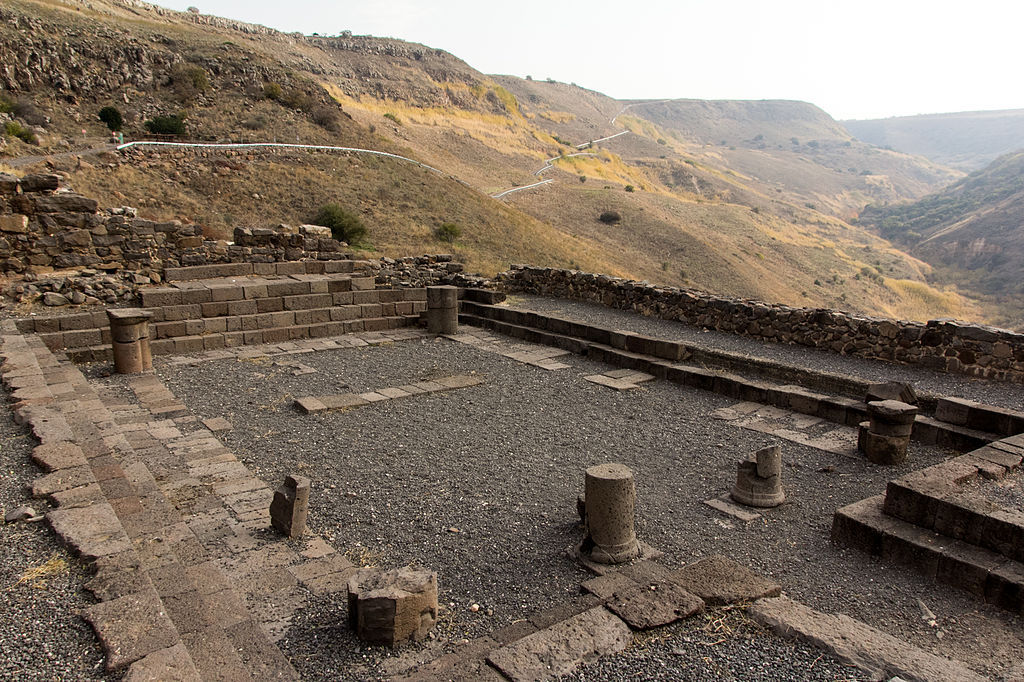
Gamla’s first-century synagogue. Photo: Oren Rozen via Wikimedia Commons, (CC BY-SA 3.0).
The New Testament describes various settings for Jesus’ ministry—from the Temple in Jerusalem to the shores and mountains of Galilee. There is another frequent setting that might not immediately come to mind: synagogues. In fact, many of Jesus’ miracles and teachings took place in synagogues, where Jesus and other early Jews frequently gathered for discussion and worship.
In the Spring 2023 issue of Biblical Archaeology Review, Jordan J. Ryan of Wheaton College investigates the role of synagogues in Jesus’ ministry in his article, “Jesus in the Synagogue.” He takes readers on an archaeological and textual survey of first-century synagogues in Galilee and Judea. Not only does this reveal the centrality of the synagogue to ancient Jewish life, but also it shows the significance of the synagogue in the New Testament.
Ryan identifies 16 synagogues dated before 135 CE from sites in Judea and Galilee: Beth Shemesh, Capernaum, Gamla, Herodium, Jericho, Jerusalem (in the form of the Theodotus Inscription), Khirbet Cana, Khirbet Majduliyya, Khirbet Wadi Hamam, Magdala (two synagogues uncovered), Masada, Modi’in (Umm el-Umdan), Qiryat Sefer (Khirbet Badd Isa), Shikhin, and Tel Rekhesh. This large dataset is thanks, in part, to some excavations from the past decade.
Synagogues from this period share certain features, including a central hall supported by pillars and lined with benches. Ryan elaborates:
Synagogue buildings in the early Roman period featured a main assembly hall, which was quadrilateral in shape. Stepped benches typically lined the walls, meaning that the attendees sat facing the center of the room, and people seated along opposite walls would have faced one another. The seating arrangement was thus designed to facilitate discussion, particularly among people seated along different and especially opposite walls. … Synagogue assembly rooms also typically featured columns, usually in the central floor area, which supported a clerestory ceiling. The columns would have obscured the view of the central floor from the benches, which indicates that synagogues were likely designed with hearing rather than seeing in mind. In short, the architectural evidence reveals that synagogues of the early Roman period were places of community assembly, made for listening and discussing.
Synagogues served many purposes in ancient Galilee and Judea. Not only were they places of worship, but they also functioned as a town hall, court of law, community center, and even guesthouse. Some served specific groups, but many belonged to the public:
As premier gathering places, synagogues that belonged to the municipality were political institutions, much like town halls, as much as they were religious institutions (see in the Mishnah, e.g., Nedarim 5:5). These are what some scholars call “public synagogues.” A clear example of a public synagogue in the New Testament would be the synagogue at Nazareth mentioned in Luke 4:16–30 (cf. Mark 6:1–6).
However, synagogues could also belong to a specific group, such as the Synagogue of the Freedmen in Acts 6:9. Such synagogues, which are similar to clubs, are called “association synagogues.” They would have been gathering places for the group to which they belonged rather than for the general population and would not have had the “town hall” function of public synagogues.

In the New Testament when Jesus enters and teaches in synagogues, these should be understood as public synagogues, where dialogue and debate would have been expected. Throughout the New Testament, we see such debate between Jesus and other Jewish religious leaders. Ryan explains:
In the Gospels, when Jesus and the synagogue assemblies are engaged in discussion and debate, they are doing something normative that synagogues were designed to facilitate. This is, for example, how we should understand the depiction of the lengthy back-and-forth discussion between Jesus and the synagogue assembly at Capernaum in the Bread of Life Discourse (John 6:25–59). The debate between Jesus and a synagogue official in Luke 13:10–17 over the legality of healing on the Sabbath is an example of a synagogue dispute. The story ends with Jesus successfully answering the official’s challenge with a compelling reply, such that his opponents are put to shame and the crowd rejoices at his deeds, indicating that the public was persuaded by Jesus’s response. In this case, we see the assembly deciding in favor of the legality of Jesus’s act of Sabbath healing against the opinion of a local elite.
After understanding the centrality of the synagogue to ancient Jewish culture, it should come as no surprise that the synagogue featured so prominently in Jesus’ ministry. Learn more about early Roman synagogues—and their role in the New Testament—in Jordan J. Ryan’s article “Jesus in the Synagogue,” published in the Spring 2023 issue of Biblical Archaeology Review, and in his book The Role of the Synagogue in the Aims of Jesus (Fortress Press, 2017).
Read more in Bible History Daily:
Archaeologists Discover New First-Century Synagogue in Magdala, Israel
Read more in the BAS Library:
https://ift.tt/n0hQlC4
The post Jesus and Synagogues appeared first on Biblical Archaeology Society.


0 Commentaires